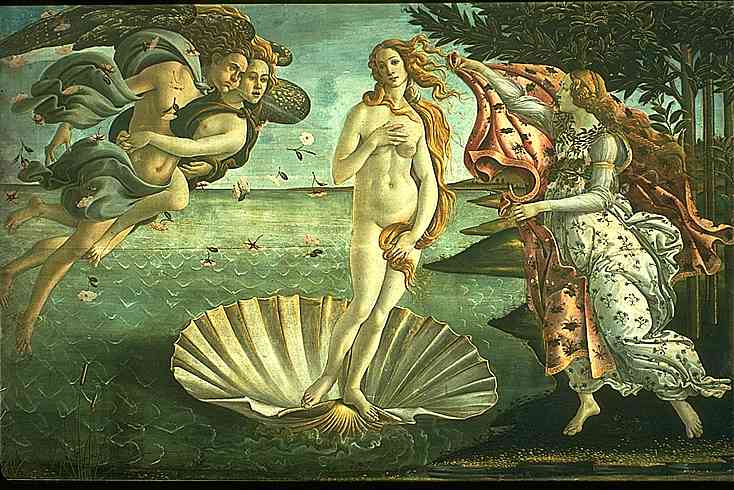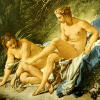 The idea that I want to work with in this post is the role that contemporary art – from incredibly detailed fantasy artists like Howard David Johnson and Vallejo and Bell to the, dare I say, feminist art of painters like Sandra M. Stanton and Hrana Janto to the photography of people like Hein Lass and Suza Scalora – plays in our interpretations and use of ancient Greek myths.
The idea that I want to work with in this post is the role that contemporary art – from incredibly detailed fantasy artists like Howard David Johnson and Vallejo and Bell to the, dare I say, feminist art of painters like Sandra M. Stanton and Hrana Janto to the photography of people like Hein Lass and Suza Scalora – plays in our interpretations and use of ancient Greek myths.
Images on ancient pots definitely played an important role in the dissemination and long-term survival of various myths. During the Renaissance, Classical subject matter became wildly popular and accompanied a resurgence of interest in certain myths as well. And, on a personal level, I was an enormous fan of D’Aulaire’s Greek Myths as a kid (by the way, take the poll down on the right and tell me what myth book you’re most likely to have on your shelf), and always best remembered the stories by their illustrations. To explain a little more academically on why this matters, I’ll use the words of Claire L. Lyons and Ann Olga Koloski-Ostrow from their own introduction (NAKED TRUTHS ABOUT CLASSICAL ART):
Because classical works of art have traditionally served as paradigms of Western European values, tastes, and styles in the visual arts, the task of revealing the iconographic messages that naturalize gender and sexual roles is an important one. Such artworks and artifacts were not only primary vehicles of communication in their own time, but continued to have a profound impact for centuries after and still have the power to shape how we see the past and relate it to the present.
 As I’ve mentioned in other places, a big part of the reason I began this website is because there really wasn’t much online that combined myth and image, and nothing the way I envisioned it. When I started posting images alongside the descriptions of characters, I started getting flack. The nudity in the paintings (there weren’t photographs back then) was called porn and inappropriate for young people. Later, when I taught mythology to a group of middle schoolers, I was asked not to show them any of the Classical or contemporary art that I had picked out (such racy images as Botticelli’s Birth of Venus at right). Never mind that my focus was on the depictions of such stories through varying media!
As I’ve mentioned in other places, a big part of the reason I began this website is because there really wasn’t much online that combined myth and image, and nothing the way I envisioned it. When I started posting images alongside the descriptions of characters, I started getting flack. The nudity in the paintings (there weren’t photographs back then) was called porn and inappropriate for young people. Later, when I taught mythology to a group of middle schoolers, I was asked not to show them any of the Classical or contemporary art that I had picked out (such racy images as Botticelli’s Birth of Venus at right). Never mind that my focus was on the depictions of such stories through varying media!
The fact is that in ancient Greek art, women are rarely nude – especially goddesses1 – with the sometime exception of Aphrodite, so all this nakedness appeared to be coming from the artists’ interpretations. In fact, the paintings were depicting a great deal of what their makers felt about stuff like gender and sexuality and class. And, it turns out, a lot of what I thought I “knew” about various women in greek myths, actually came from general impressions I’d gained from illustrations. I loved the strong independent goddesses Athena and Artemis – depicted with their weapons and often alone – but felt a sort of feministy loathing for the naked and weak Aphrodite, covering herself and lounging among her underlings (remember the class thing I mentioned? servants are just not part of my world), and Hera, sitting so isolated and bougie on her throne.
But you’re on the internet! You’re not limited to one artist’s – or even one website’s – interpretation on these matters. Of course, you will still be effected by general trends and what Google’s popularity rankings (or my preferences) present you with, but your opportunities for varying opinions are astronomical! If a picture’s worth a thousand words (and when it comes to mythical characters, I think that might be an understatement), then you’ve got the friggin’ Library of Congress at your fingertips. Take a moment, if you will, and visit my Gallery. Take a look at the incredible range of interpretations of a goddess like Artemis, for example, gives you a wholly different perspective on who she is:
Of course there’s more to be said. But the possibilities for discussion seem overwhelming to me right now, so I’ll leave it at this introduction to the relationship between art and women in Greek myths for today. Has this inspired any thoughts of your own? Are there any iconic images that have really stuck with you? Leave me a comment below.




Leave a Reply